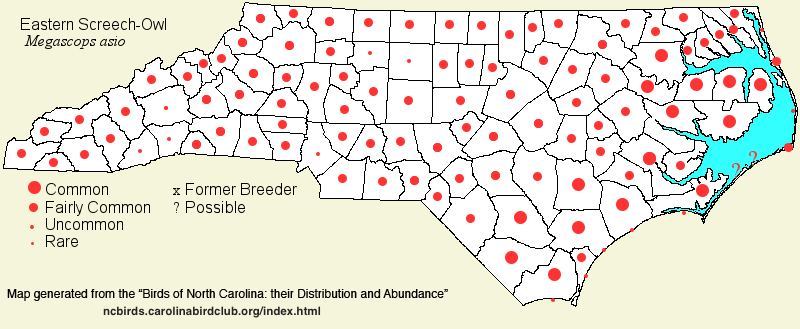 |  |
|
Eastern Screech-Owl - Megascops asio STRIGIDAE Members: | Search Common: Search Scientific: |
|
|
|||||||
| General Comments | The Eastern Screech-Owl is one of three widespread and familiar owls in the state, along with the Great Horned and Barred. Screech-Owls can often be found in wooded residential areas, occasionally nesting in boxes erected for them. But, they are most frequent in medium-growth pine forests and mixed pine-hardwood forests, both in uplands and in lowlands. Favored sites have small openings, or are adjacent to fields. Numbers have declined in the past two decades, perhaps owing to development of many of our drier forests; perhaps some of the decline has been due to collisions with vehicles. Formerly, these owls were not hard to hear with playback of calls or an imitation of the calls, but such efforts are becoming less reliable now with fewer owls around. | ||||||
| Breeding Status | Breeder | ||||||
| NC BRC List | Definitive | ||||||
| State Status | |||||||
| U.S. Status | |||||||
| State Rank | S5 | ||||||
| Global Rank | G5 | ||||||
| Coastal Plain | Permanent resident, essentially non-migratory; declining. Fairly common to locally common across the province; present in numbers in Buxton Woods on Hatteras Island, but scarce to absent on islands without forested cover. Formerly, prior to about 2000, was common across most of the province, but almost certainly now is mostly fairly common at best. Peak counts: ? | ||||||
| Piedmont | Permanent resident, probably non-migratory; declining. Generally fairly common, on the whole, but perhaps locally uncommon now. Often common prior to about 1995 or 2000. Peak counts: ? | ||||||
| Mountains | Permanent resident, probably non-migratory. Uncommon to fairly common, mainly below 4,000 feet; presumed to be declining. Less numerous in the province than in other regions, though still probably the most numerous owl species in the region. Peak counts: ? | ||||||
| Finding Tips |
This owl normally calls infrequently on its own, and you must usually get the birds to respond to a call. Best to try in rather mature and slightly open forests; they seldom occur in thickets or young wooded stands. Either a taped call, or your own whistling, will do. However, you need to be patient, for it usually takes three to five minutes of calls to get one to several to respond. This can be done anytime at night. The owls, however, do not call as frequently in twilight conditions, so it is best to call for them at least one-half hour after sunset or more than one-half hour before sunrise. To see them, you can spotlight a calling bird in a flashlight beam. However, keep the light on one for only a handful of seconds. ** to *** | ||||||
| Attribution | LeGrand[2023-03-21], LeGrand[2014-01-03], LeGrand[2012-07-11] | ||||||
| NC Map Map depicts all counties with a report (transient or resident) for the species. | Click on county for list of all known species. |
| NC Breeding Season Map Map depicts assumed breeding season abundance for the species. |  |